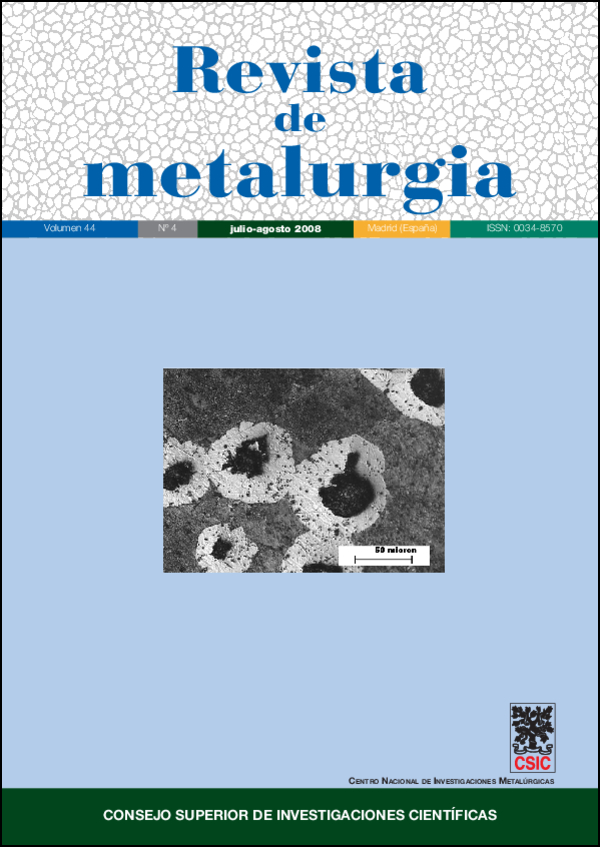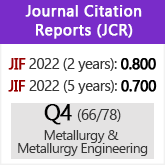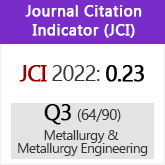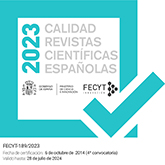Fatigue behaviour of single overlap joints on steel and pre-painting steel with epoxy adhesive
DOI:
https://doi.org/10.3989/revmetalm.2008.v44.i4.120Keywords:
Adhesive joint, Epoxy, Surface Finís, FatigueAbstract
The mechanical properties of adhesive joints depend not only on the nature and properties of the adhesives; there are many parameters which influence the behaviour of the adhesive joints. Some of more significant parameters are: the surface conditions of materials, area and thickness of adhesive layer, compatibility of the design, applying sequence, chemical properties of surface and the surface treatments of substrates prior to be bonded. The mechanical resistance of adhesive joints is interrelated to the fracture process depended on cohesion-adhesion mechanism. The aim of this paper is analyse the influence of two different surfaces on the fatigue behaviour of epoxy adhesive joints. The results show that chemical compatibility of adhesive and paint improve adhesion of joints and the mechanical resistance against static and dynamic loads. The fatigue limited has been obtained for joints with both surfaces.
Downloads
References
[1] P. Cognard, Adhesives and Sealants. Basic Concepts and High Tech Bonding, Ed. Elsevier. Oxford, U.K., 2005, pp. 238, 23, 261.
[2] Loctite, Worldwide Desing Handbook, Ed. Loctite, Munich, Alemania, 1995, pp. 147-163.
[3] M. Madrid, Tecnología de la Adhesión, Ed. Loctite, Madrid, España, 2002 pp. 18-20, 158-168 y 129-139.
[4] B. Duncan, S. Abbott, R. Court, R. Roberts y D. Leatherdale, A Review of Adhesive Bonding Assembly Processes and Measurement Methods, Ed. National Physical Laboratory Teddington, Middlesex, UK, 2003, pp. 25-35.
[5] C.A. Dostal, Adhesives and Sealants (Engineered Materials Handbook), Ed. CRC Press, New York, 1990.
[6] A.V. Pocins, Adhesion and Adhesives Technology, Ed. Hanser-Gardner, Cincinnati, 1997.
[7] J.M. Martín-Martínez, Adhesión y uniones adhesivas, Ed. Universidad de Alicante, 1998, p. 31.
[8] S. Gómez et al, Int. J. Adhes. Adhesives 27 (2007) 263-267. doi:10.1016/j.ijadhadh.2006.01.004
[9] E.M. Petrie, Handbook of Adhesives and Sealants Ed. McGraw Hill, New York, 1999. pp. 26, 61 y 361.
[10] R. Houwink y G. Salomón, Adherencia y adhesivos, Ed. Urmo, Tomo I, Bilbao, 1978, pp. 127- 130.
[11] H. Hadavinia et al, Int. J. Adhes. Adhesives 23 (2003) 449-461. doi:10.1016/S0143-7496(03)00074-5
[12] EU 10169, Productos planos de acero recubiertos en continuo de materiales orgánicos (precalentados), 2000.
[13] UNE-EN 1465:1996, Adhesivos. Determinación de la resistencia a la cizalladura por tracción de juntas pegadas de substratos rígidos, 1996.
[14] UNE-EN ISO 9664:1996, Adhesivos. Métodos de ensayo para resistencia a la fatiga por esfuerzo de cizalla de adhesivos estructurales, 1996.
[15] J. Durán, J.M. Amo, C. Durán, J. Oñoro, R. García-Ledesma, Rev. Metal. Madrid Vol. Extr. (2005) 345-350.
[16] R. García-Ledesma, J. Oñoro, J.M. Amo, M.C. Durán y J. Durán, Rev. Metal. Madrid 41 (2005) 60-65.
[17] P.R. Underhill y D.L. Duquesnay, Int. J. Adhes. Adhesives 26 (2006) 62-66. doi:10.1016/j.ijadhadh.2005.03.006
[18] M. Dessurealut y J. K. Spelt, Int. J. Adhes. Adhesives 17 (1997) 183-195. doi:10.1016/S0143-7496(96)00044-9
Downloads
Published
How to Cite
Issue
Section
License
Copyright (c) 2008 Consejo Superior de Investigaciones Científicas (CSIC)

This work is licensed under a Creative Commons Attribution 4.0 International License.
© CSIC. Manuscripts published in both the printed and online versions of this Journal are the property of Consejo Superior de Investigaciones Científicas, and quoting this source is a requirement for any partial or full reproduction.All contents of this electronic edition, except where otherwise noted, are distributed under a “Creative Commons Attribution 4.0 International” (CC BY 4.0) License. You may read here the basic information and the legal text of the license. The indication of the CC BY 4.0 License must be expressly stated in this way when necessary.
Self-archiving in repositories, personal webpages or similar, of any version other than the published by the Editor, is not allowed.


















